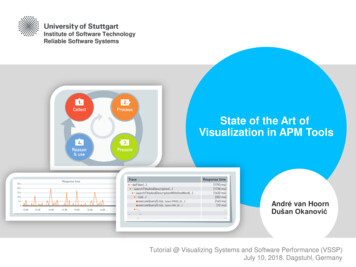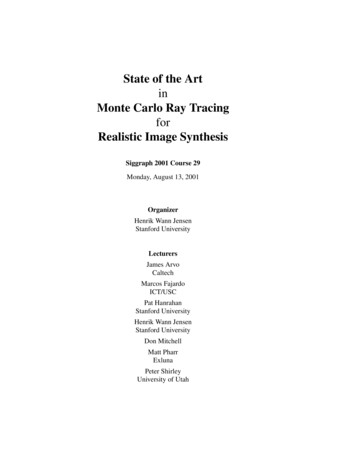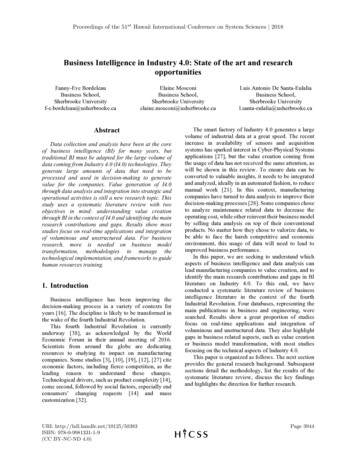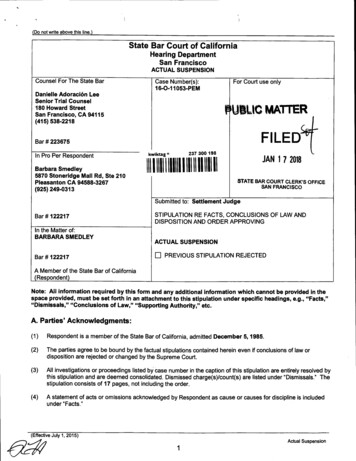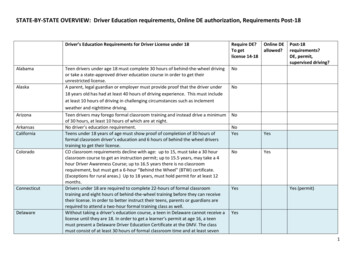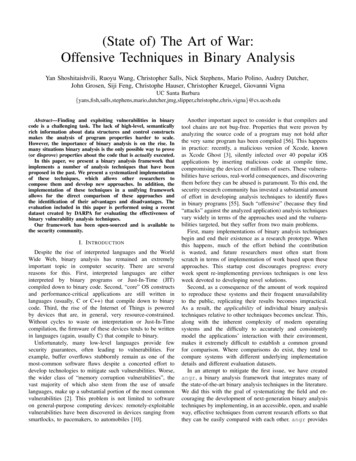
Transcription
(State of) The Art of War:Offensive Techniques in Binary AnalysisYan Shoshitaishvili, Ruoyu Wang, Christopher Salls, Nick Stephens, Mario Polino, Audrey Dutcher,John Grosen, Siji Feng, Christophe Hauser, Christopher Kruegel, Giovanni VignaUC Santa ct—Finding and exploiting vulnerabilities in binarycode is a challenging task. The lack of high-level, semanticallyrich information about data structures and control constructsmakes the analysis of program properties harder to scale.However, the importance of binary analysis is on the rise. Inmany situations binary analysis is the only possible way to prove(or disprove) properties about the code that is actually executed.In this paper, we present a binary analysis framework thatimplements a number of analysis techniques that have beenproposed in the past. We present a systematized implementationof these techniques, which allows other researchers tocompose them and develop new approaches. In addition, theimplementation of these techniques in a unifying frameworkallows for the direct comparison of these approaches andthe identification of their advantages and disadvantages. Theevaluation included in this paper is performed using a recentdataset created by DARPA for evaluating the effectiveness ofbinary vulnerability analysis techniques.Our framework has been open-sourced and is available tothe security community.I. I NTRODUCTIONDespite the rise of interpreted languages and the WorldWide Web, binary analysis has remained an extremelyimportant topic in computer security. There are severalreasons for this. First, interpreted languages are eitherinterpreted by binary programs or Just-In-Time (JIT)compiled down to binary code. Second, “core” OS constructsand performance-critical applications are still written inlanguages (usually, C or C ) that compile down to binarycode. Third, the rise of the Internet of Things is poweredby devices that are, in general, very resource-constrained.Without cycles to waste on interpretation or Just-In-Timecompilation, the firmware of these devices tends to be writtenin languages (again, usually C) that compile to binary.Unfortunately, many low-level languages provide fewsecurity guarantees, often leading to vulnerabilities. Forexample, buffer overflows stubbornly remain as one of themost-common software flaws despite a concerted effort todevelop technologies to mitigate such vulnerabilities. Worse,the wider class of “memory corruption vulnerabilities”, thevast majority of which also stem from the use of unsafelanguages, make up a substantial portion of the most commonvulnerabilities [2]. This problem is not limited to softwareon general-purpose computing devices: remotely-exploitablevulnerabilities have been discovered in devices ranging fromsmartlocks, to pacemakers, to automobiles [10].Another important aspect to consider is that compilers andtool chains are not bug-free. Properties that were proven byanalyzing the source code of a program may not hold afterthe very same program has been compiled [56]. This happensin practice: recently, a malicious version of Xcode, knownas Xcode Ghost [3], silently infected over 40 popular iOSapplications by inserting malicious code at compile time,compromising the devices of millions of users. These vulnerabilities have serious, real-world consequences, and discoveringthem before they can be abused is paramount. To this end, thesecurity research community has invested a substantial amountof effort in developing analysis techniques to identify flawsin binary programs [55]. Such “offensive” (because they find“attacks” against the analyzed application) analysis techniquesvary widely in terms of the approaches used and the vulnerabilities targeted, but they suffer from two main problems.First, many implementations of binary analysis techniquesbegin and end their existence as a research prototype. Whenthis happens, much of the effort behind the contributionis wasted, and future researchers must often start fromscratch in terms of implementation of work based upon theseapproaches. This startup cost discourages progress: everyweek spent re-implementing previous techniques is one lessweek devoted to developing novel solutions.Second, as a consequence of the amount of work requiredto reproduce these systems and their frequent unavailabilityto the public, replicating their results becomes impractical.As a result, the applicability of individual binary analysistechniques relative to other techniques becomes unclear. This,along with the inherent complexity of modern operatingsystems and the difficulty to accurately and consistentlymodel the applications’ interaction with their environment,makes it extremely difficult to establish a common groundfor comparison. Where comparisons do exist, they tend tocompare systems with different underlying implementationdetails and different evaluation datasets.In an attempt to mitigate the first issue, we have createdangr, a binary analysis framework that integrates many ofthe state-of-the-art binary analysis techniques in the literature.We did this with the goal of systematizing the field and encouraging the development of next-generation binary analysistechniques by implementing, in an accessible, open, and usableway, effective techniques from current research efforts so thatthey can be easily compared with each other. angr provides
building blocks for many types of analyses, using both staticand dynamic techniques, so that proposed research approachescan be easily implemented and their effectiveness comparedto each other. Additionally, these building blocks enable thecomposition of analyses to leverage their different strengths.Over the last year, a solution has also been introducedto the second problem, aimed towards comparing analysistechniques and tools, with research reproducibility in mind.Specifically, DARPA organized the Cyber Grand Challenge,a competition designed to explore the current state ofautomated binary analysis, vulnerability excavation, exploitgeneration, and software patching. As part of this competition,DARPA wrote and released a corpus of applications thatare specifically designed to present realistic challenges toautomated analysis systems and produced the ground truth(labeled vulnerabilities and exploits) for these challenges. Thisdataset of binaries provides a perfect test suite with whichto gauge the relative effectiveness of various analyses thathave been recently proposed in the literature. Additionally,during the DARPA CGC qualifying event, teams around theworld fielded automated binary analysis systems to attack anddefend these binaries. Their results are public, and provide anopportunity to compare existing offensive techniques in theliterature against the best that the competitors had to offer1 .Our goal is to gain an understanding of the relative efficacyof modern offensive techniques by implementing them in ourbinary analysis system. In this paper, we detail the implementation of a next-generation binary analysis engine, angr. Wepresent several offensive analyses that we developed usingthese techniques (specifically, replications of approachescurrently described in the literature) to reproduce resultsin the fields of vulnerability discovery, exploit replaying,automatic exploit generation, compilation of ROP shellcode,and exploit hardening. We also describe the challenges thatwe overcome, and the improvements that we achieved, bycombining these techniques to augment their capabilities.By implementing them atop a common analysis engine, wecan explore the differences in effectiveness that stem fromthe theoretical differences behind the approaches, rather thanimplementation differences of the underlying analysis engines.This has enabled us to perform a comparative evaluation ofthese approaches on the dataset provided by DARPA.In short, we make the following contributions:1) We reproduce many existing approaches in offensivebinary analysis, in a single, coherent framework, toprovide an understanding of the relative effectiveness ofcurrent offensive binary analysis techniques.2) We show the difficulties (and solutions to thosedifficulties) of combining diverse binary analysistechniques and applying them on a large scale.3) We open source our framework, angr, for the use offuture generations of research into the analysis of binarycode.1 The top-performing 7 teams each won a prize of 750, 000 USD. Weexpect that, with this motivation, the teams fielded the best analyses thatwere available to them.II. AUTOMATED B INARY A NALYSISResearchers have been striving toward automated binaryanalysis techniques for many years. However, despite recentadvances in this field, such systems are challenging to developand deploy in the real world. This is because, dependingon the technique in question, there are serious limitationsthat must be overcome to perform automated analysis onreal-world software. In this section, we will touch on thechallenges of automated analysis and discuss why the DARPACyber Grand Challenge contest can provide a meaningfulway to compare different analysis approaches.A. Trade-offsIt is not hard to see why binary analysis is challenging:in a sense, asking “will it crash?” is analogous to asking“will it stop?”, and any such analysis quickly runs afoul ofthe halting problem [32]. Program analyses, and especiallyoffensive binary analyses, tend to be guided by carefullybalanced theoretical trade-offs to maintain feasibility. Thereare two main areas where such trade-offs must be made:Replayability. Bugs are not all created equal. Dependingon the trade-offs made by the system, bugs discovered bya given analysis might not be replayable. This boils downto the scope that an analysis operates on. Some analysesexecute the whole application, from the beginning, so theycan reason about what exactly needs to be done to triggera vulnerability. Other systems analyze individual pieces ofan application: they might find a bug in a specific module,but cannot reason about how to trigger the execution of thatmodule, and therefore, cannot automatically replay the crash.Semantic insight. Some analyses lack the ability to reasonabout the program in semantically meaningful ways. Forexample, a dynamic analysis might be able to trace the codeexecuted by an application but not understand why it wasexecuted or what parts of the input caused the applicationto act in that specific way. On the other hand, a symbolicanalysis that can determine the specific bytes of inputresponsible for certain program behaviors would have ahigher semantic understanding.In order to offer replayability of input or semantic insight,analysis techniques must make certain trade-offs. For example,high replayability is associated with low coverage. This isintuitive: since an analysis technique that produces replayableinput must understand how to reach any code that it wantsto analyze, it will be unable to analyze as much code as ananalysis that does not. On the other hand, without being ableto replay triggering inputs to validate bugs, analyses that donot prioritize bug replayability suffer from a high level offalse positives (that is, flaw detections that do not representactual vulnerabilities). In the absence of a replayable input,these false positives must be filtered by heuristics which can,in turn, introduce false negatives.Likewise, in order to achieve semantic insight into theprogram being analyzed, an analysis must store and process a
large amount of data. A semantically-insightful dynamic analysis, for example, might store the conditions that must hold inorder for specific branches of a program to be taken. On theother hand, a static analysis tunes semantic insight through thechosen data domain – simpler data domains (i.e., by trackingranges instead of actual values) represent less semantic insight.Analyses that attempt both reproducibility and a highsemantic understanding encounter issues with scalability.Retaining semantic information for the entire application, fromthe entry point through all of the actions it might take, requiresa processing capacity conceptually identical to the resourcesrequired to execute the program under all possible conditions.Such analyses do not scale, and, in order to be applicable,must discard information and sacrifice soundness (that is, theguarantee that all potential vulnerabilities will be discovered).Aside from these fundamental challenges, there are alsoimplementation challenges. The biggest one of these is theenvironment model. Any analysis with a high semantic understanding must model the application’s interaction with its environment. In modern operating systems, such interactions areincredibly complex. For example, modern versions of Linuxinclude over three hundred system calls, and for an analysissystem to be complete, it must model the effects of all of them.solver. Additionally, it should be able to prove that thememcpy on line 16 cannot overflow. However, the executionwill likely not be able to find the bug at line 30, as there aretoo many potential paths which do not trigger the bug.12int main(void) {char buf[32];3char *data read string();unsigned int magic read number();456// difficult check for fuzzingif (magic 0x31337987) {// buffer overflowmemcpy(buf, data, 100);}789101112if (magic 100 && magic % 15 2 &&magic % 11 6) {// Only solution is 17; safememcpy(buf, data, magic);}131415161718// Symbolic execution will suffer from// path explosionint count 0;for (int i 0; i 100; i ) {if (data[i] 'Z') {count ;}}19202122232425Example. To demonstrate the various challenges of binaryanalysis, we provide a concrete example of a program withmultiple vulnerabilities in Listing 1. For clarity and space reasons, this example is simplified, and it is meant only to exposethe reader to ideas that will be discussed later in the paper.Observe the three call
(State of) The Art of War: Offensive Techniques in Binary Analysis Yan Shoshitaishvili, Ruoyu Wang, Christopher Salls, Nick Stephens, Mario Polino, Audrey Dutcher, John Grosen, Siji Feng, Christophe Hauser, Christopher Kruegel, Giovanni Vigna UC Santa Barbara er,christophe,chris,vignag@cs.ucsb.edu




